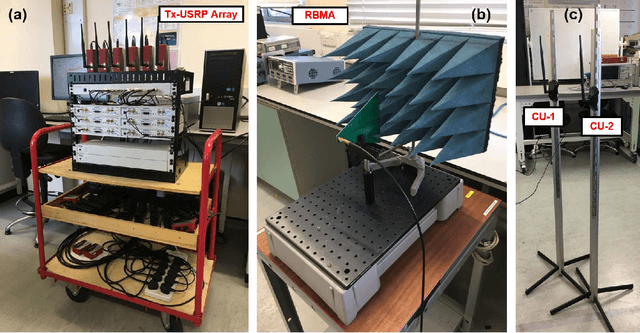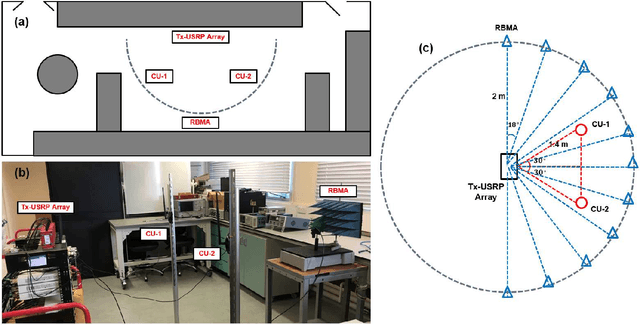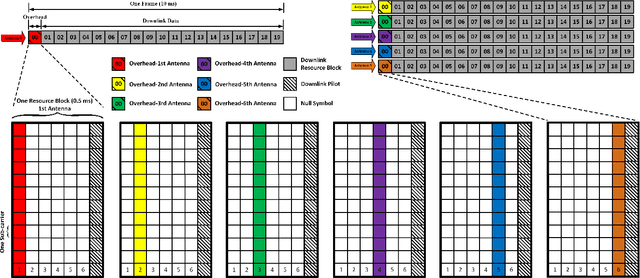Tongyang Xu
Non-Orthogonal AFDM: A Promising Spectrum-Efficient Waveform for 6G High-Mobility Communications
Jul 23, 2025Abstract:This paper proposes a spectrum-efficient nonorthogonal affine frequency division multiplexing (AFDM) waveform for reliable high-mobility communications in the upcoming sixth-generation (6G) mobile systems. Our core idea is to introduce a compression factor to enable controllable subcarrier overlapping in chirp-based AFDM modulation. To mitigate intercarrier interference (ICI), we introduce linear precoding at the transmitter and an iterative detection scheme at the receiver. Simulation results demonstrate that these techniques can effectively reduce interference and maintain robust bit error rate (BER) performance even under aggressive compression factors and high-mobility channel conditions. The proposed non-orthogonal AFDM waveform offers a promising solution for next-generation wireless networks, balancing spectrum efficiency and Doppler resilience in highly dynamic environments.
OFDM-Standard Compatible SC-NOFS Waveforms for Low-Latency and Jitter-Tolerance Industrial IoT Communications
Jun 07, 2024



Abstract:Traditional communications focus on regular and orthogonal signal waveforms for simplified signal processing and improved spectral efficiency. In contrast, the next-generation communications would aim for irregular and non-orthogonal signal waveforms to introduce new capabilities. This work proposes a spectrally efficient irregular Sinc (irSinc) shaping technique, revisiting the traditional Sinc back to 1924, with the aim of enhancing performance in industrial Internet of things (IIoT). In time-critical IIoT applications, low-latency and time-jitter tolerance are two critical factors that significantly impact the performance and reliability. Recognizing the inevitability of latency and jitter in practice, this work aims to propose a waveform technique to mitigate these effects via reducing latency and enhancing the system robustness under time jitter effects. The utilization of irSinc yields a signal with increased spectral efficiency without sacrificing error performance. Integrating the irSinc in a two-stage framework, a single-carrier non-orthogonal frequency shaping (SC-NOFS) waveform is developed, showcasing perfect compatibility with 5G standards, enabling the direct integration of irSinc in existing industrial IoT setups. Through 5G standard signal configuration, our signal achieves faster data transmission within the same spectral bandwidth. Hardware experiments validate an 18% saving in timing resources, leading to either reduced latency or enhanced jitter tolerance.
A Low-Cost Multi-Band Waveform Security Framework in Resource-Constrained Communications
Feb 01, 2024Abstract:Traditional physical layer secure beamforming is achieved via precoding before signal transmission using channel state information (CSI). However, imperfect CSI will compromise the performance with imperfect beamforming and potential information leakage. In addition, multiple RF chains and antennas are needed to support the narrow beam generation, which complicates hardware implementation and is not suitable for resource-constrained Internet-of-Things (IoT) devices. Moreover, with the advancement of hardware and artificial intelligence (AI), low-cost and intelligent eavesdropping to wireless communications is becoming increasingly detrimental. In this paper, we propose a multi-carrier based multi-band waveform-defined security (WDS) framework, independent from CSI and RF chains, to defend against AI eavesdropping. Ideally, the continuous variations of sub-band structures lead to an infinite number of spectral features, which can potentially prevent brute-force eavesdropping. Sub-band spectral pattern information is efficiently constructed at legitimate users via a proposed chaotic sequence generator. A novel security metric, termed signal classification accuracy (SCA), is used to evaluate the security robustness under AI eavesdropping. Communication error probability and complexity are also investigated to show the reliability and practical capability of the proposed framework. Finally, compared to traditional secure beamforming techniques, the proposed multi-band WDS framework reduces power consumption by up to six times.
Index Modulation Pattern Design for Non-Orthogonal Multicarrier Signal Waveforms
Apr 18, 2022



Abstract:Spectral efficiency improvement is a key focus in most wireless communication systems and achieved by various means such as using large antenna arrays and/or advanced modulation schemes and signal formats. This work proposes to further improve spectral efficiency through combining non-orthogonal spectrally efficient frequency division multiplexing (SEFDM) systems with index modulation (IM), which can efficiently make use of the indices of activated subcarriers as communication information. Recent research has verified that IM may be used with SEFDM to alleviate inter-carrier interference (ICI) and improve error performance. This work proposes new SEFDM signal formats based on novel activation pattern designs, which limit the locations of activated subcarriers and enable a variable number of activated subcarriers in each SEFDM subblock. SEFDM-IM system designs are developed by jointly considering activation patterns, modulation schemes and signal waveform formats, with a set of solutions evaluated under different spectral efficiency scenarios. Detailed modelling of coded systems and simulation studies reveal that the proposed designs not only lead to better bit error rate (BER) but also lower peak-to-average power ratio (PAPR) and reduced computational complexity relative to other reported index-modulated systems.
An Experimental Proof of Concept for Integrated Sensing and Communications Waveform Design
Feb 09, 2022



Abstract:The integration of sensing and communication (ISAC) functionalities have recently gained significant research interest as a hardware-, power-, spectrum- and cost- efficient solution. This experimental work focuses on a dual-functional radar sensing and communication framework where a single radiation waveform, either omnidirectional or directional, can realize both radar sensing and communication functions. We study a trade-off approach that can balance the performance of communications and radar sensing. We design an orthogonal frequency division multiplexing (OFDM) based multi-user multiple input multiple output (MIMO) software-defined radio (SDR) testbed to validate the dual-functional model. We carry out over-the-air experiments to investigate the optimal trade-off factor to balance the performance for both functions. On the radar performance, we measure the output beampatterns of our transmission to examine their similarity to simulation based beampatterns. On the communication side, we obtain bit error rate (BER) results from the testbed to show the communication performance using the dual-functional waveform. Our experiment reveals that the dual-functional approach can achieve comparable BER performance with pure communication-based solutions while maintaining fine radar beampatterns simultaneously.
Waveform-Defined Privacy: A Signal Solution to Protect Wireless Sensing
Dec 21, 2021



Abstract:Wireless signals are commonly used for communications. Emerging applications are giving new functions to wireless signals, in which wireless sensing is the most attractive one. Channel state information (CSI) is not only the parameter for channel equalization in communications but also the indicator for wireless sensing. However, due to the broadcast nature of wireless signals, eavesdroppers can easily capture legitimate user signals and violate user privacy by measuring CSI. Moreover, the advancement of hardware simplifies illegal eavesdropping since smart devices can track over-the-air signals through walls. Therefore, this work considers a waveform-defined privacy (WDP) solution that can hide CSI phase information and therefore protect user privacy. Besides, the proposed waveform solution achieves better performance due to the use of a unique modulation mechanism. Additionally, by tuning a waveform parameter, the waveform can also enhance communication security.
Waveform-Defined Security: A Low-Cost Framework for Secure Communications
Dec 21, 2021



Abstract:Communication security could be enhanced at physical layer but at the cost of complex algorithms and redundant hardware, which would render traditional physical layer security (PLS) techniques unsuitable for use with resource-constrained communication systems. This work investigates a waveform-defined security (WDS) framework, which differs fundamentally from traditional PLS techniques used in today's systems. The framework is not dependent on channel conditions such as signal power advantage and channel state information (CSI). Therefore, the framework is more reliable than channel dependent beamforming and artificial noise (AN) techniques. In addition, the framework is more than just increasing the cost of eavesdropping. By intentionally tuning waveform patterns to weaken signal feature diversity and enhance feature similarity, eavesdroppers will not be able to identify correctly signal formats. The wrong classification of signal formats would result in subsequent detection errors even when an eavesdropper uses brute-force detection techniques. To get a robust WDS framework, three impact factors, namely training data feature, oversampling factor and bandwidth compression factor (BCF) offset, are investigated. An optimal WDS waveform pattern is obtained at the end after a joint study of the three factors. To ensure a valid eavesdropping model, artificial intelligence (AI) dependent signal classifiers are designed followed by optimal performance achievable signal detectors. To show the compatibility in available communication systems, the WDS framework is successfully integrated in IEEE 802.11a with nearly no adding computational complexity. Finally, a low-cost software-defined radio (SDR) experiment is designed to verify the feasibility of the WDS framework in resource-constrained communications.
Deep Learning for Over-the-Air Non-Orthogonal Signal Classification
Nov 14, 2019



Abstract:Non-cooperative communications, where a receiver can automatically distinguish and classify transmitted signal formats prior to detection, are desirable for low-cost and low-latency systems. This work focuses on the deep learning enabled blind classification of multi-carrier signals covering their orthogonal and non-orthogonal varieties. We define two signal groups, in which Type-I includes signals with large feature diversity while Type-II has strong feature similarity. We evaluate time-domain and frequency-domain convolutional neural network (CNN) models in simulation with wireless channel/hardware impairments. Simulation results reveal that the time-domain neural network training is more efficient than its frequency-domain counterpart in terms of classification accuracy and computational complexity. In addition, the time-domain CNN models can classify Type-I signals with high accuracy but reduced performance in Type-II signals because of their high signal feature similarity. Experimental systems are designed and tested, using software defined radio (SDR) devices, operated for different signal formats to form full wireless communication links with line-of-sight and non-line-of-sight scenarios. Testing, using four different time-domain CNN models, showed the pre-trained CNN models to have limited efficiency and utility due to the mismatch between the analytical/simulation and practical/real-world environments. Transfer learning, which is an approach to fine-tune learnt signal features, is applied based on measured over-the-air time-domain signal samples. Experimental results indicate that transfer learning based CNN can efficiently distinguish different signal formats in both line-of-sight and non-line-of-sight scenarios with great accuracy improvement relative to the non-transfer-learning approaches.
 Add to Chrome
Add to Chrome Add to Firefox
Add to Firefox Add to Edge
Add to Edge